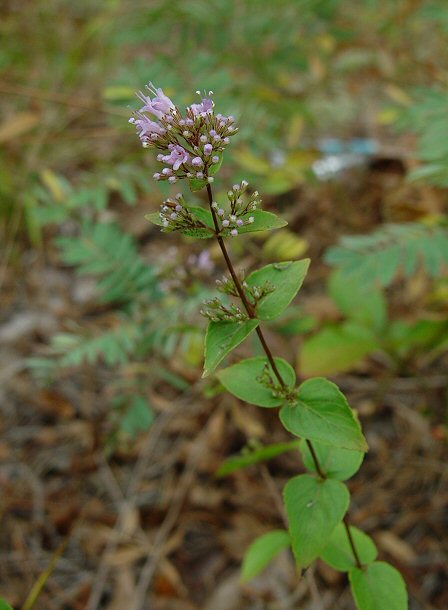Cunila origanoides (L.) Britton
Dittany

Native
CC = 6
CW = 5
MOC = 56
© DETenaglia
Cunila origanoides (L.) BrittonDittany | |
 |
Native CC = 6 CW = 5 MOC = 56 |
© DETenaglia |
|
Family - Lamiaceae Habit - Perennial forb with a somewhat woody rootstock and short, slender rhizomes. Stems - Ascending to erect, to 50 cm, multiple from base, 4-angled, usually well branched, glabrous or sparsely pubescent with short, spreading and/or, crinkly hairs, sometimes mostly along the angles or along 2 opposing, slightly concave sides, brown and appearing woody.
Leaves - Opposite, simple, sessile or nearly so. Blades 1.5-4.0 cm long, 0.7-2.0 cm wide, narrowly to broadly ovate, rounded or occasionally shallowly cordate at the base, angled or tapered to a sharply pointed tip, the margins finely toothed or rarely entire, the surfaces glabrous or sparsely to moderately pubescent along the main veins with stiff, spreading, multicellular hairs, also with relatively conspicuous sessile glands. Herbage fragrant with an odor similar to that of oregano.
Inflorescences - Dense, terminal and axillary clusters of 6 to numerous flowers, these short-stalked to nearly sessile (0.5-2.0 mm). Bracts inconspicuous (to 1 mm long), linear to narrowly lanceolate, shorter than the flowers. Inflorescence divisions often pubescent with tufts of hispid hairs.
Flowers - Calyces 1.5-3.0 mm long at flowering, actinomorphic, funnelform to narrowly bell-shaped, the tube strongly 10-nerved, with a fringe of short, bristly hairs in the mouth, the lobes shorter than the tube, narrowly triangular, glandular on the outer surface. Corollas 6-8 mm long, weakly zygomorphic, pinkish purple to lavender, the surfaces moderately to densely and minutely hairy, also glandular, the tube funnelform, slightly 2-lipped, the lips up to half as long as the tube, the upper lip notched at the broadly rounded tip, straight or slightly arched, the lower lip 3-lobed, arched to spreading. Stamens 2, strongly exserted, the anthers small, the connective short, the pollen sacs 2, parallel or nearly so, yellowish purple to nearly white. Ovary deeply lobed, the style appearing nearly basal from a deep apical notch. Style not or only slightly exserted, with 2 slender branches at the tip.
Fruits - Dry schizocarps, separating into usually 2-4 nutlets, these 0.8-1.0 mm long, ellipsoid to ovoid, the surface yellowish brown to brown, glabrous, smooth or very finely pebbled.
Flowering - July - November. Habitat - Upland forests, savannas, upland prairies, ledges and tops of bluffs, streambanks, fields, roadsides; often on acidic substrates. Origin - Native to the U.S. Lookalikes - None close. Other info. - This species is found in Missouri within a sharply delineated, southeastern half of the state. Beyond Missouri its range extends southward throughout most of Arkansas, and also eastward to the Atlantic Coast. The plant is quite common within its range, and is easily identified by its axillary clusters of lavender colored flowers, each of these having two strongly exserted stamens. The leaf shape is distinctive, and with a little practice the plant can be identified even when no flowers are present. Photographs taken at Roaring River State Park, Barry County, MO., 8-25-00, and in the Ozark Scenic Riverways, Shannon County, MO., 8-28-03 (DETenaglia); also at LaBarque Creek Conservation Area, Jefferson County, MO, 8-22-2010, Earthquake Hollow Natural Area, Callaway County, MO, 9-19-2015, Little Lost Creek Conservation Area, Warren County, MO, 10-10-2020, and Don Robinson State Park, Jefferson County, MO, 9-2-2021 (SRTurner). |